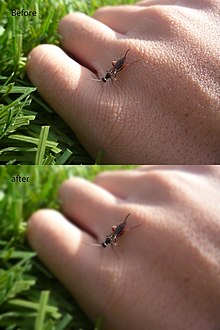Image editing encompasses the processes of altering images, whether they are digital photographs, traditional photo-chemical photographs, or illustrations. Traditional analog image editing is known as photo retouching, using tools such as an airbrush to modify photographs or editing illustrations with any traditional art medium. Graphic software programs, which can be broadly grouped into vector graphics editors, raster graphics editors, and 3D modelers, are the primary tools with which a user may manipulate, enhance, and transform images. Many image editing programs are also used to render or create computer art from scratch.
Basics of image editing
Raster images are stored in a computer in the form of a grid of picture elements, or pixels. These pixels contain the image's color and brightness information. Image editors can change the pixels to enhance the image in many ways. The pixels can be changed as a group, or individually, by the sophisticated algorithms within the image editors. This article mostly refers to bitmap graphics editors, which are often used to alter photographs and other raster graphics. However, vector graphics software, such as Adobe Illustrator, CorelDRAW, Xara Designer Pro or Inkscape, are used to create and modify vector images, which are stored as descriptions of lines, Bézier curves, and text instead of pixels. It is easier to rasterize a vector image than to vectorize a raster image; how to go about vectorizing a raster image is the focus of much research in the field of computer vision. Vector images can be modified more easily because they contain descriptions of the shapes for easy rearrangement. They are also scalable, being rasterizable at any resolution.
Automatic image enhancement
Camera or computer image editing programs often offer basic automatic image enhancement features that correct color hue and brightness imbalances as well as other image editing features, such as red eye removal, sharpness adjustments, zoom features and automatic cropping. These are called automatic because generally they happen without user interaction or are offered with one click of a button or mouse button or by selecting an option from a menu. Additionally, some automatic editing features offer a combination of editing actions with little or no user interaction.
Digital data compression
Many image file formats use data compression to reduce file size and save storage space. Digital compression of images may take place in the camera, or can be done in the computer with the image editor. When images are stored in JPEG format, compression has already taken place. Both cameras and computer programs allow the user to set the level of compression.
Some compression algorithms, such as those used in PNG file format, are lossless, which means no information is lost when the file is saved. By contrast, the more popular JPEG file format uses a lossy compression algorithm (based on discrete cosine transform coding) by which the greater the compression, the more information is lost, ultimately reducing image quality or detail that can not be restored. JPEG uses knowledge of the way the human brain and eyes perceive color to make this loss of detail less noticeable.
Image editor features
Listed below are some of the most used capabilities of the better graphics manipulation programs. The list is by no means all-inclusive. There are a myriad of choices associated with the application of most of these features.
Selection
One of the prerequisites for many of the applications mentioned below is a method of selecting part(s) of an image, thus applying a change selectively without affecting the entire picture. Most graphics programs have several means of accomplishing this, such as:
- a marquee tool for selecting rectangular or other regular polygon-shaped regions,
- a lasso tool for freehand selection of a region,
- a magic wand tool that selects objects or regions in the image defined by proximity of color or luminance,
- vector-based pen tools,
as well as more advanced facilities such as edge detection, masking, alpha compositing, and color and channel-based extraction. The border of a selected area in an image is often animated with the marching ants effect to help the user to distinguish the selection border from the image background.
Layers
Another feature common to many graphics applications is that of Layers, which are analogous to sheets of transparent acetate (each containing separate elements that make up a combined picture), stacked on top of each other, each capable of being individually positioned, altered and blended with the layers below, without affecting any of the elements on the other layers. This is a fundamental workflow which has become the norm for the majority of programs on the market today, and enables maximum flexibility for the user while maintaining non-destructive editing principles and ease of use.
Image size alteration
Image editors can resize images in a process often called image scaling, making them larger, or smaller. High image resolution cameras can produce large images which are often reduced in size for Internet use. Image editor programs use a mathematical process called resampling to calculate new pixel values whose spacing is larger or smaller than the original pixel values. Images for Internet use are kept small, say 640 x 480 pixels which would equal 0.3 megapixels.
Cropping an image
Digital editors are used to crop images. Cropping creates a new image by selecting a desired rectangular portion from the image being cropped. The unwanted part of the image is discarded. Image cropping does not reduce the resolution of the area cropped. Best results are obtained when the original image has a high resolution. A primary reason for cropping is to improve the image composition in the new image.
 Uncropped image from camera |
Lily cropped from larger image |





